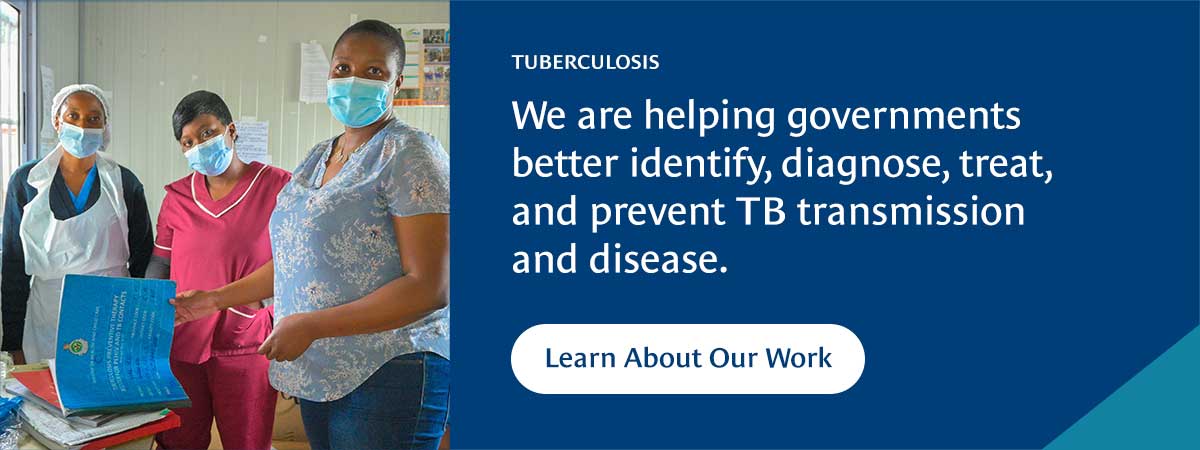Drug-resistant tuberculosis (DR-TB) is on the rise globally with an estimated 450,000 new cases in 2021.[1] However, only one in three DR-TB patients worldwide receive lifechanging treatment with a success rate between 50-60 percent. As a result, there is increased urgency to establish innovative and effective treatment models through shorter regimens for DR-TB to end the TB pandemic. In response, the World Health Organization (WHO) has recommended a novel, shorter DR-TB regimen comprising fewer drug combinations for the treatment of DR-TB.
Until recently, the uptake of new shorter TB regimens and integration of WHO guidelines into policy and practice in low-and middle-income countries (LMICs), where DR-TB is high, has been slow. The slow uptake has been due to several factors, including the complexity of rolling out DR-TB regimens, high cost of DR-TB drugs, high-level laboratory capacity requirements, associated costs of transitioning to new regimens; and lack of coordination among stakeholders to operationalize scale up.
What is BPaL(M) and how is it shaping the DR-TB treatment space?
BPaL(M) is a novel, oral, six-month regimen comprising bedaquiline, pretomanid, and linezolid that can be used with moxifloxacin where there is resistance to fluroquinolones. The regimen was first studied in South Africa under the Nix-TB[2] Phase 3 clinical trial with several subsequent clinical and observational studies establishing its applicability in country settings. After the South African-based pilot, the WHO in May 2022, issued guidance for countries for the use of the BPaL(M) regimen for treating almost all forms of DR-TB in patients aged 14 years and above.[3]
In June 2022, the Clinton Health Access Initiative (CHAI), with the South Africa National TB Control Program (NTP), convened an international conference on DR-TB regimen optimization and sequence alignment for TB (ROSA-TB) with the overall goal of facilitating the uptake of effective, shorter, all-oral DR-TB regimens in high DR-TB burden countries with a primary focus on accelerating BPaL(M) regimen uptake. The conference aimed to: (a) establish consensus on DR-TB treatment options and implications for associated diagnostics and clinical care, (b) identifying critical operational and technical barriers for regimen transition, including evidence gaps, and (c) outlining key principles for transitioning to new DR-TB regimen. It established consensus on the state of BPaL(M) regimen introduction, expanding on existing standards of national transition plans to expedite a robust rollout of the new, prioritized DR-TB treatment regimen (i.e., BPaL(M)), recognizing related diagnostic needs as critical.
The SA NTP, with technical assistance from CHAI, highlighted preparatory work needed for the introduction of BPaL(M) for other countries to follow suit. Taking heed of the call to action, Zimbabwe established a localized BPaL(M) implementation plan. Developed with support from CHAI, the plan include a minimum requirement process map across key implementation pillars such as policy, monitoring and evaluation (M&E), supply chain, clinical management, demand generation and active drug safety monitoring and management (aDSM). With an actionable roadmap for the rollout of the BPaL(M) regimen in Zimbabwe, the country is poised to rollout the regimen in Q2 of 2023 with commodities already in place for disbursement.
What can the TB Community do to accelerate the uptake of shorter DR-TB regimens such as BPaL(M)?
Although country policy decisions to accept WHO guidance are necessary and progressive, it is not sufficient for implementation and public health impact. Bold multilateral investments are needed to reverse recent increases in the TB burden and get on track to meet global goals to end TB, and these include:
- Establishing periodic knowledge sharing platforms and forums such a ROSA-TB to enhance countries’ collective ability to implement novel regimens such as BPaL(M), including awareness on new trends in the TB pipeline, best practices, and mitigation strategies to implementation bottlenecks.
- Increased investments in direct technical assistance in new regimen uptake, including efficient integration of newer regimen tools and process indicators into existing programming.
- Continued market shaping initiatives between countries, donors, and pharmaceutical companies to ensure that life-changing regimens such as BPaL(M) are more accessible to LMICs.
- Increased investments in active drug safety monitoring and management and social protection initiatives as enablers for positive treatment outcomes, especially among DRTB patients.
- Establishing local level multi-stakeholder technical working groups as accountability mechanisms to support strategic planning and efficient use of existing resources when rolling out new regimens.
Shorter TB regimens are a gamechanger and have great potential in improving treatment outcomes to people who need them most; however, they require continued investments in health systems strengthening and appropriate infrastructure as they are transitioned into use at all levels of care.
[2] Nix-TB Clinical Trial https://www.tballiance.org/portfolio/trial/5089
[3] WHO. Consolidated guidelines on tuberculosis: Module 4 Treatment: Drug-Resistant Tuberculosis 2022 [15.12.2022] Available from: https://apps.who.int/iris/rest/bitstreams/1485675/retrieve






